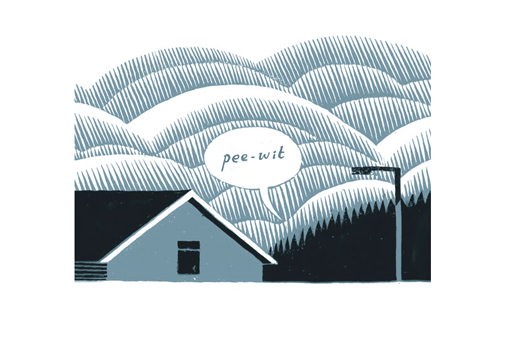 illustration by Jon McNaught
illustration by Jon McNaught
Words by Cheryl Tipp.
An extract from the new Caught by the River book, On Nature.
To be able to identify a bird by its voice alone can be extremely rewarding. The human ear is a highly sensitive device and together with the brain is more than capable of learning and identifying a whole host of bird songs and calls. It just takes practice, patience and a desire to learn. Here in the British Isles we are incredibly lucky to have such a wealth of different birds that enhance our acoustic environment with such a huge variety of sounds. In many cases you’re more likely to hear a bird rather than see it, especially in habitats with plenty of hiding places such as woodlands and reedbeds.
Some birds like to give us a helping hand (or should that be wing?) and actually say their name when they vocalise. The two syllable “cuc-koo” lets everyone know that a male Cuckoo is in the area, having returned to the British countryside from his African wintering grounds. This familiar harbinger of spring is not an easy bird to see, so being able to recognise its distinctive call does have its advantages. Another summer migrant with an onomatopoeic name is the Chiffchaff. This small brown warbler sings a simple “chiff-chaff” phrase over and over again from the relative safety of trees and shrubs. Again, this is not an easy bird to spot, but the sound of its distinctive song soon gives the game away. The colloquial name for the Lapwing, the Peewit, is derived from its wheezy, drawn-out “pee-wit” call, while the Curlew takes its common name from the evocative “cour-loo” cry that can be heard across moors and marshes throughout the year.
Other birds seem to be saying specific sentences, or at least somebody once thought they were and, luckily for us, the phrases have stuck. The Collared Dove produces a loud cooing song that can either be interpreted as “u-nit-ed” (easy to remember if you happen to be a Man U fan) or “I don’t know”. Just have a listen to the song and hopefully you’ll see what I mean. The song of the Yellowhammer takes a little more imagination but the phrase “a little bit of bread and no cheese” is a pretty good description of this high-pitched tune that is best heard in and around farmland areas.
Of course you don’t have to be in the countryside to encounter wildlife. Urban environments offer food and shelter to many species and in some cases you are more likely to come upon certain birds in towns and cities than anywhere else. It’s not always easy to single out wildlife sounds when the acoustic environment is saturated with traffic, sirens, building work and the general day to day hum of urban life, but with enough practice and attention to detail you can train your ears to filter out the unwanted noise and focus in on those songs and calls. For several consecutive years, a male Black Redstart used the wind vane on top of London’s St Pancras Station as a song post. Anyone who has passed through this part of the capital will know that it’s not exactly the quietest of places. Despite the constant stream of taxis, buses, cars and people, the song of the Black Redstart could still be heard above the madness of rush hour. Granted, the song was somewhat smothered by the general din, but the hurried warble and scratchy jumble of notes was still an audible component of the urban soundscape.
A great way to try out your listening prowess is with a little springtime test. The dawn chorus is one of the highlights of the year for nature lovers and can be experienced in both urban and rural settings. The test will involve getting up early (sorry about that) but I can promise you that it will be well worth it. Immersing yourself in the dawn chorus can be a magical experience. The air is filled with chirps, tweets, sweet melodies and vibrant songs, all of which create a natural symphony that never fails to impress. To begin with, just soak up the atmosphere and enjoy the simple pleasure of listening. The dawn chorus can last for several hours so you’ll have more than enough time to do both. Then try to pick out individual songs and calls. Even if you don’t necessarily know which species is producing that sound, you should start to identify patterns and rhythms within the general chorus that are being created by different species. Team this awareness with an audio identification guide and you’ll soon be able to put names to voices. There’s a whole new acoustic world out there just waiting to be explored so prick up your ears and start listening!